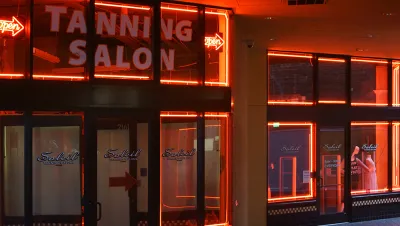There's more to vibrant than access to fresh-made baguettes and signage with tastefully chosen typefaces.

Your vibrant urban neighborhood is now passé.
Researchers at the University of California released a groundbreaking study titled, "On New Thresholds of Significance for the Vibrant State of Neighborhoods in Urban Environments." The big discovery buried in the jargon: the existence of neighborhoods that can be described as a step above vibrant, or "hella vibrant."
The study's breakthrough came after researchers identified a previously overlooked signifier of vibrancy. "Previous attempts at measuring vibrancy identified factors like access to transit, walkability, mixed-use buildings, proximity to vegan restaurants, a live music scene, and a sprinkling of diversity," explains the study's lead author, Nedry Newman. "We realized that just measuring the corporate music scene wasn't enough; you also have to measure the Indie music scene."
In hindsight it seems silly that researchers hadn't thought to measure the contribution of Indie music venues in previous studies. "Probably too much time pouring over datasets in front of my computer rather than actually experiencing the city," admits Newman.
Critics of the study questioned whether the study was designed as a response to a growing backlash against the use of the term vibrant as a catchall phrase devoid of all meaning. "Vibrancy is a marketing term for greedy developers who think you can just press a button and revitalize a neighborhood," said Longfellow Merriweather, director of communications for the Center for Neighborhood Integrity. "When will academics study how to protect all these neighborhoods with hella character?"
Newman, however, rejects the idea that vibrant only has public relations value: "You know vibrant when you see it. But you have to see hella vibrant to believe it."
Adding to the evidence in support of the existence of hella vibrant neighborhoods were additional findings from widespread academic inquiry into new levels of vibrant. Researchers at MIT released a study the next day identifying several "wicked vibrant" urban areas in and around Boston, and University of Toronto researchers released a study titled "Vibrant, Eh?".
[A previous version of this story incorrectly identified the study's lead author as Nerdry Newman. We apologize for the error.]
FULL STORY: April Fool's Day

Analysis: Cybertruck Fatality Rate Far Exceeds That of Ford Pinto
The Tesla Cybertruck was recalled seven times last year.

National Parks Layoffs Will Cause Communities to Lose Billions
Thousands of essential park workers were laid off this week, just before the busy spring break season.

Retro-silient?: America’s First “Eco-burb,” The Woodlands Turns 50
A master-planned community north of Houston offers lessons on green infrastructure and resilient design, but falls short of its founder’s lofty affordability and walkability goals.

Test News Post 1
This is a summary

Analysis: Cybertruck Fatality Rate Far Exceeds That of Ford Pinto
The Tesla Cybertruck was recalled seven times last year.

Test News Headline 46
Test for the image on the front page.
Urban Design for Planners 1: Software Tools
This six-course series explores essential urban design concepts using open source software and equips planners with the tools they need to participate fully in the urban design process.
Planning for Universal Design
Learn the tools for implementing Universal Design in planning regulations.
EMC Planning Group, Inc.
Planetizen
Planetizen
Mpact (formerly Rail~Volution)
Great Falls Development Authority, Inc.
HUDs Office of Policy Development and Research
NYU Wagner Graduate School of Public Service




























